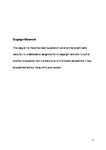Development of a framework for sustainable repair of adobe building in an urban area in Nigeria
| dc.contributor.supervisor | Watson, Linda | |
| dc.contributor.author | Shittu, Theophilus Adeyinka | |
| dc.contributor.other | School of Art, Design and Architecture | en_US |
| dc.date.accessioned | 2012-05-24T08:56:40Z | |
| dc.date.available | 2012-05-24T08:56:40Z | |
| dc.date.issued | 2012 | |
| dc.identifier | 313224 | en_US |
| dc.identifier.uri | http://hdl.handle.net/10026.1/1008 | |
| dc.description.abstract |
Building with earth is still a living practice in Nigeria most especially in the northern region. Pear shaped sun-dried earth brick (tubali) was used traditionally by the Hausa in northern Nigeria. However, the use of tubali has ceased to exist in favour of the adobe blocks in both the urban and rural settlements in Nigeria. Sabon Gari, the study area is one of the urban areas in this region with buildings constructed with adobe. However, these adobe buildings are in deplorable conditions and in dire need of repair. Sabon Gari in Kaduna was selected as the thesis’ study area because of its strategic location and the dual function which the adobe buildings serve (i.e. residential and commercial purposes). This provided an opportunity to study the effect of the two activities on adobe building in an urban area. 20 compounds with buildings constructed with adobe blocks were selected and thoroughly examined. In the course of this study it was identified that the major factors inhibiting the repair of these buildings are social factors. This thesis therefore argued that with an appropriate framework these social factors can be corrected. Consequently, the adobe building in Sabon Gari can be repaired. This informed the decision to develop a repair framework through participatory approach involving the adobe building’s stakeholders, which include tenants, landlords, architects, masons and the planning authority. In the course of the development of this repair framework, this thesis draws on, and contextualises its argument on the fact that tried and tested repair strategies exists at international levels, which can be adapted to the situation in Sabon Gari. Consequently, ideas from relevant building repair literature, Terra conferences papers, earthen architecture conservation projects and adobe building repair projects were critically analysed and used in developing the proposed repair framework for Sabon Gari. To ensure the sustainability of the framework, which is one of the research aims, the content of the framework was validated by some of the stakeholders interviewed at the inception of this research. This proposal was amended based on the stakeholders’ recommendations and now has the input and approval of the stakeholders. | en_US |
| dc.description.sponsorship | Commonwealth Scholarship Commission | en_US |
| dc.language.iso | en | en_US |
| dc.publisher | University of Plymouth | en_US |
| dc.subject | Architecture | en_US |
| dc.title | Development of a framework for sustainable repair of adobe building in an urban area in Nigeria | en_US |
| dc.type | Thesis | |
| dc.identifier.doi | http://dx.doi.org/10.24382/4006 | |
| dc.identifier.doi | http://dx.doi.org/10.24382/4006 |
Files in this item
This item appears in the following Collection(s)
-
01 Research Theses Main Collection
Research Theses Main


